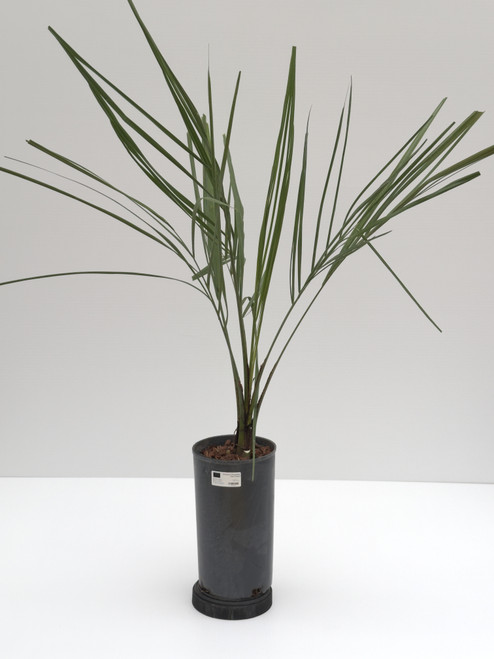Product Description
Habitat and distribution
Butia odorata is native to the grasslands, and dry woodlands and savannahs of South America. Populations range across a wide area of northern Argentina, southern Brazil, Paraguay and Uruguay.
Description
Long pinnate leaves that arch and recurve towards the ground from atop a thick stout trunk. The trunk can grow to 20 feet, but normally reaches 12-15 ft (3.7-4.6 m) with a diameter of 1-1.5 ft (0.3-0.5 m). Typically, the old leaf stalks persist for years, although specimens with clean trunks are not uncommon. Leaves range from light green to bluish gray, and grow 5 to 10 feet long. The leaf stems range from about 2-4 ft (0.6-1.2 m) in length, and the petiole is armed. The palm produces bright orange fruit (often called pindo dates in the Deep South). These palms vary in form from one individual to the next. Specimens raised in dry and/or infertile soils tend to be smaller in stature with smaller leaves. Light also affects the plant's form while those grown in full sun are more compact.
Trees 3-5 m tall, 40-50 cm in diam.; complete sheathing leaf base not seen, petiole 70-88 cm long; 4-7 cm wide at base, margins mostly armed with fairly short teeth on upper portion, coarsely spiny on lower part and adjacent sheathing base, spines 8-11 cm long; rachis of leaf 150-183 cm long; pinnae 63-80 on each side, regularly arranged, middle ones 60-75 cm long, 1.5-2.5 cm, with oblique, asymmetrical tips; expanded part of spathe 80-100 cm long, 7.0-8.5 cm wide, smooth or striate, more or less glaucous, becoming eglaucous with age; bran~hed part of spadix 85-94 cm long, rachIllae 50-60, 62-69 cm long; pistil. late flowers rounded or ovoid, 4-8 mm long, 4-6 mm in diam.; lower staminate flowers 7-10 mm long, those above 4-7 mm long; mature fruit orange, with soft mesocarp when ripe, ovoid, 1.8-2.6 cm long, 1.5-2.2 cm in diam., with short beak, persistent perianth 0.4-0.6 cm high, locules 1-3, seed ovoid or triangu. lar, 1.8-2.4 cm long, 1.0-1.4, cm in diam. (S.F. Glassman. 1979)/Palmweb. Editing by edric.
This palm was also known incorrectly as Butia capitata for many years. The true Butia capitata was first described and named by Martius as Cocos capitata in 1826. It was discovered in the state of Minas Gerais by Martius near the town of Montes Claros and is a cerrado-loving palm endemic to the central planalto region of Brazil. It is a very different palm from the more robust coastal plane or restinga-loving "Butia capitata" of Uruguay and Rio Grande do Sul, Brazil. Barbosa Rodrigues (1891, 1903) described and named the southern one as Cocos odorata and wrote that it inhabited fields in Rio Grande do Sul and on the Isla de los Padres near the Rio Cebollati (Lagoa Mirim), Uruguay. Beccari (1916) half-heartedly accepted Barbosa Rodrigues' name when he created Butia capitata var. odorata (Barb. Rodr.) Becc. Glassman (1979) synonymized both of these names under Butia capitata expressing a need for further study. Henderson (1999), reiterating my own view, wrote that "They (the southern population) should perhaps be recognized as a separate species, in which case Butia odorata would be the correct name (Larry Noblick, pers. comm.)." Since then, others have supported, but failed to transfer Cocos odorata to Butia odorata. In his PhD thesis, Marcato (2004) created the name Butia odorata (Barb.Rodr.) Noblick ex Marcato, but he never published his thesis nor the name. Lorenzi et al. (2004) published the name Butia odorata (Barb.Rodr.) Noblick & Pirani, but it lacked a proper basionym reference, and the transfer failed. Finally, Lorenzi et al. (2010) published Butia odorata Noblick & Lorenzi, but it had an erroneous basionym reference that rendered the name illegitimate. Therefore, let the above transfer be considered the final, legal and official transfer of Cocos odorata Barb. Rodr. to Butia, with its correct basionym reference. (L. Noblick. 2011) L. Noblick, Validation of the name Butia odorata in Palms (1999+) 55 (1). 2011.
Culture
Requirements: Full sun to moderate shade (the fronds grow longer in shady situations, giving the palm a more graceful aspect than those grown in full sun). Prefers sandy, well drained soil but is adaptable and very drought tolerant. Regular watering and feeding will produce a faster growing, more attractive palm.Grown: USDA Zone 8-9. Specimens can be seen in North Carolina and I've had reports of a Butia spotting in Washington D.C. On the west coast the Pindo palm is grown as a novelty in warmer Zone 8 microclimates as far north as British Columbia. This palm is not recommended for subtropical and tropical climates.









